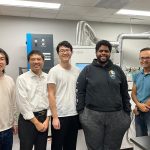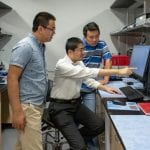Biography
Dr. Feng received his B.S. in Physics from Peking University in 2007, his M.S. in Physics from Tsinghua University in 2009, and his Ph.D. in Materials Science and Engineering from the University of California, Berkeley in December 2013. He spent two and a half years as a Postdoctoral Scholar at Stanford University before joining UCF as an Assistant Professor in August 2016.
Research Area
Electrocatalysis plays a key role in the energy conversion processes that are central to renewable energy technologies such as fuel cells and electrolyzers. My research focuses on the understanding of structure-activity relationships for electrocatalytic materials and the development of efficient electrocatalysts for energy conversion. In situ scanning probe microscopy (SPM) and synchrotron-based X-ray spectroscopy will be used to characterize the solid-liquid interface and reveal new active sites. Those understandings will then be used to guide the design and synthesis of electrocatalysts (e.g., metal nanostructures, 2D materials) for fuel cells and artificial photosynthesis (water splitting and CO2 reduction).
Research Opportunities for Students
Dr. Feng’s group focuses on the rational design of nanomaterials and devices for electrochemical energy conversion. Electrocatalysis plays a central role in the energy conversion processes for renewable energy technologies, such as using renewable electricity to drive chemical reactions for the sustainable production of chemicals and fuels without carbon emissions. In particular, we are dedicated to the conversion of waste gas and wastewater into valuable chemicals and fuels. For example, efficient electrocatalysts can convert carbon dioxide to chemicals and fuels such as ethanol, ethylene, and propanol, and can also recycle nitrate in wastewater to ammonia, which is a key component of agricultural fertilizers that account for 45% of the world’s food production. To design efficient electrocatalysts, we must understand the structure–activity relationships of nanomaterials and establish design principles. We use various methods including hydrothermal synthesis, colloidal synthesis, vapor deposition, and electrodeposition to develop nanomaterials with well-defined structure and chemical state, which are characterized by different techniques (SEM, TEM, XRD, XPS, AFM, and Raman) and then evaluated for electrocatalytic reactions. We further use in situ and operando scanning probe microscopy and synchrotron-based X-ray spectroscopy to probe the solid-liquid interface and understand the active sites and underlying mechanisms.
Information on requirements:
Currently accepting:
Graduate: Yes
Undergraduate: Yes
-
- Is it Paid? – Yes
- In a lab? – No
- Prerequisites – N/A
- Learning materials – N/A
Publications
Courses Taught
- Intermediate Physics Laboratory, PHY 3802L, Fall 2016.



